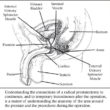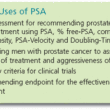Erectile Rehabilitation After Surgery

In my practice, I recommend an erectile function rehabilitation program that has two phases.
The first phase is designed to minimize the damage to the erectile nerves (sometimes called the “cavernosal” nerves) that occurs from the radical prostatectomy procedure.
I start my patients on a daily low dose 5 mg of tadalafil (Cialis) beginning 5 days before surgery and continuing for 25 days after surgery.
The second phase of my rehabilitation program involves injections of Bi-Mix (papaverine and phentolamine) into the side of the shaft of the penis (using the smallest syringe and needle manufactured) 2 to 3 times per week.
These injections produce an erection with arterial blood that, if the erection is sufficiently rigid for intercourse, usually lasts for more than one hour.
Arterial blood contains 2 and 1/2 times more oxygen than venous blood (100 vs 40) and therefore is more nourishing to the tissues, especially the smooth muscle of the penis that is critical for normal erections to occur.
I believe this phase of the rehabilitation program has four possible benefits for the patient: 1) a patient may resume his sex life right away, 2) the penis does not undergo atrophy and shrink, 3) the penile tissues and nerves heal faster, and 4) healing of the tissues that have been traumatized by the surgery is enhanced by getting more arterial blood into the surrounding tissues, including the region of the sphincter muscles.
Then, when spontaneous erections begin to return, the patients can switch to oral agents (Cialis, Viagra, Levitra, etc.) that amplify incomplete spontaneous erections.
Many patients who do not have many risk factors for erectile dysfunction (i.e., diabetes, hypertension, anti-hypertensive medications, vascular disease, smoking, tranquilizers or other psychotropic drugs, heavy alcohol use, narcotics or sleeping pills, etc.) are able to recover normal erections.
Another method is the vacuum erection device which draws blood into the penis and does produce an erection, but it is venous blood with a lower oxygen content and it tends to produce a “cold, blue” erection. In my opinion, this method is less desirable than the intracavernosal injections.
Another available option is the use of suppositories (e.g., MUSE) that can be inserted into the urethra. These are generally less effective than the injections, but some patients prefer using them.
Some of the nerve fibers that have sustained reversible damage might take 36 months or more to heal, so erections usually continue to improve for 3 years or more after surgery.
In patients whose erections do not recover sufficiently, each of these options remains as a possible permanent means of resuming erectile function.
The final option is an operation to insert an inflatable penile prosthesis that is usually quite effective and durable.
My website (www.drcatalona.com) has additional information.











